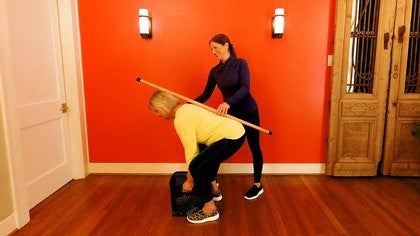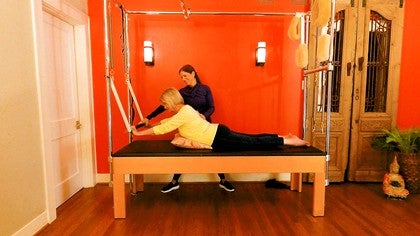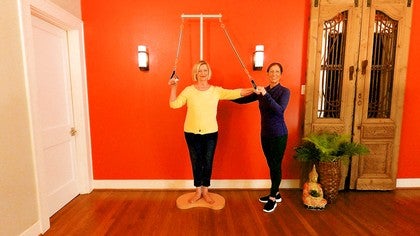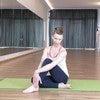Description
About This Video
Transcript
Read Full Transcript
Hi, I'm Dr. Sherri Betz, and I'm a physical therapist and Pilates teacher. And I want to share with you an assessment that I do, that's very simple. It does take a few props, but is a great way to assess an older adult with osteoporosis. This person is also a person that has peripheral neuropathy, some leg weakness, some foot pain, and we'll be addressing that as well. But today's assessment is just a general assessment, very functionally based for an older adult with osteoporosis.
So, I'd like to introduce some of the equipment that we'll be using, and that I recommend for anytime that you're working with an older adult. So, we have an AED device here. Most of the adults that I work with have a heart condition or high blood pressure. And this particular patient, Peggy, does have high blood pressure. So, it's really important that you have your emergency device available in case of emergency.
Usually, if you have it available, you don't need it, right? So, and then I also have it right next to my fire extinguisher. So, I know where all my emergency apparatus is in case of an emergency. We also have a thermometer, that's a non-contact thermometer that I use on every patient when they come into the door, to make sure they're not feverish, especially, in the time of COVID. And another thing that you might consider getting is a pulse oximeter that you can just put into the finger and really check on the oxygen saturation levels, if someone has had long COVID or has difficulty breathing, or is returning to your Pilates studio, after they have had about of COVID.
And especially, if they're having, some respiratory difficulties. It's great for them to exercise, don't be afraid to exercise with them. Certainly, you wanna push them to get stronger and to work on their endurance and their breathing, especially, that deep breathing, that's gonna be really helpful for them. As the lungs kind of heal, they can heal with scar tissue after COVID and that deep breathing activity that you're gonna be doing with them is the best thing that they could ever be doing. So, don't be afraid to work with someone that has long COVID because they really need you and your skills.
So, I'll also let you know that we'll be using a stadiometer. And if you're with people that have osteoporosis, you'll certainly wanna have a stadiometer in your clinic. Now, I have the typical medical type. You don't have to have this kind, there are some kinds that are a lot cheaper that you can attach to the wall. You do really need a contractor to do that to make sure it's perfect, because you don't wanna have it off for people's height, because that's really important to have it installed correctly, so that you're getting the right numbers of height.
So, we'll call Peggy over in just a moment, and get started on the assessment. This is my client, Peggy. She is 78 years old. She has some hypertension, glaucoma and some foot pain. The biggest problem for her is that foot pain.
She really is plagued by that, has difficulty walking, and had an accident a few weeks ago where she dropped a wheelbarrow on her foot. She was doing some and gardening and cleaning up her yard, and the wheelbarrow tilted, and it fell down on the top of her foot. And she's still having some pain from that, but she's able to do some exercise. We did a session last week and she was able to do some exercise with that foot without any repercussions. So, she's perfect for our demonstration today.
So, I'd like you to go ahead and step onto the stadiometer. We're not checking your weight. I know you're probably thrilled about that, right? And we're gonna turn you around so that you're facing the back, 'cause yes, are you gonna come up onto the back. Yes, I'm gonna get out of their way so they can see, and I'm gonna, yes, we'll pull the lateral arm out and just barely touch it to the top of her head, and I'll check the height once she steps down.
But what we can do here, which is perfect for this particular tutorial is that I can measure the back of her head, distance to the wall. This is called the occiput-to-wall distance. So, I have a little ruler here. It's kind of a clear ruler, and it's nice to be able to see through it so that I can see what I'm doing here. So, I just take it to the back of her occiput, which is the most prominent bone at the back of the skull, and then I test the difference in the position of our head away from the wall.
And the eyes have to actually be level, so I wanna take a look at that and make sure I can see her eyes that they're level, they're not looking up at the ceiling. So, she has about normally a one-inch in her usual posture. So, if you just relax for a moment, and then look straight ahead, you can see that her normal posture is usually about an inch or so away from the wall. So, when she's done a really good Pilates session and she's doing her best posture, she can actually get her head all the way back to the wall. And what that tells me is that she's flexible enough to have perfect posture, and we just need to strengthen those upper back muscles in order to have her improve her posture, all right?
So, I'm gonna let you step down here. And we'll go onto the next part of our assessment. So, we just measured her height which was five foot three and an eighth inches. And I believe her studied historical height that was her tallest measurement was about five foot four or five foot four and a half. So, she has lost about an inch to an inch and a half of height over her lifetime.
And we also measured the occiput-to-wall distance test, against the stadiometer just for the visual image for you guys at home to be able to see this a lot better, because if I had her against the wall, you wouldn't be able to see what I was doing. And that's why it's called, the occiput-to-wall distance test, 'cause it's normally done against the wall, but it's really easy to do it against your pedi pole or against a stadiometer. All right, so we'll look at her side posture here. And the most remarkable thing that I see in the side view here is the upper thoracic kyphosis, which is mild. It's not bad.
And then, if we turn her to the front, this is where the trouble starts, right? And we see that her feet are collapsed here in the arches. And she has a pretty good bunion that's developing on the right side. She also has a hammer toe on the left side, so she has lots of things we can work on. And she tends to stand with her feet turned out a little bit, and then most of the weight on the inside of the arches.
She does not have con in genital flat foot. This has developed over time due to peripheral neuropathy, where she feels burning and numbness in her feet. And those arches have collapsed over time. Being her daughter, I have witnessed this, so I've seen it happen over her lifetime. Okay, so now, what I want you to do is turn to the side again.
All right, and then I want you to reach your arms straight in front of you, and then bend your knees and just do a little knee bend there. And I'm gonna look at her ankle dorsiflexion. So, notice how when she turns her feet out, that ankles roll in a little bit to get her knees to bend. So that's looking at the ankle dorsiflexion. Stand straight, back up again.
All right, and then bring your feet all the way together. This will sometimes help with fixing that postural alignment. Now, bend your knees, and then the arches won't roll in quite as readily, that looks really good, okay? Now, I'm gonna let you turn around and face the back. And if you could step closer to the wall, please.
Perfect, okay, so now this one, a lot of people call this the muffin top test and they laugh when I do it with them, but it's a really good test to do on a regular basis before and after your Pilates classes. So, if you find your crest of your pelvis, and put your fingers right in there on the crest of the pelvis, and then find the line of the armpit, all the way down the side seam of your shirt. So usually, finding the side seam of your T-shirt's a good way to find it, and just let your arms relax. And I'm gonna stick my fingers in here. And sometimes, this makes people giggle, but the three fingers is ideal.
Four fingers is even better. Five fingers is the most I've ever seen to get between the 10th rib and the top of the pelvis. We call this the rib-to-pelvis test, and I can get two fingers in there. And so, that would be the minimum required to get a normal score. Two, three or four fingers is what we want.
And then one finger or zero fingers is abnormal, and it demonstrates collapse in the lumbar spine. All right, the occipital distance test actually, demonstrates collapse in the thoracic spine. So, if you have wedging in the thoracic vertebrae, it'll show up there. So, those two tests are really easy for you to do on a regular basis if you're monitoring your own body or your client's body. All right, so go ahead and face me, and then we're gonna face the camera if you don't mind.
And I want you to stand with your feet all the way together right now. So, that's the first part of what we call the four-stage balance test. Standing with your feet all the way together, prevents a lot of times rolling inward into the arches. It can challenge your balance a little bit, and it's really hard to slump with your feet all the way together. So, that's a great way to test your balance, all right?
So, she's doing pretty good with that. Cross your hands over your chest, all right? And now, what I want you to do, is step half of a step forward, so that the arch of your foot is kind of in the middle, just like this. If you can see my feet here, just half a step forward, just like that. So, your feet are still pointing straight ahead and they're very narrow in their stance, good.
Okay, that's what we call semi-tandem. And now, step back and do the same thing on the other with the other foot leading. And try to keep that right foot turned forward, instead of turned out, swing your heel out just a little bit. Yep, see it's, you don't realize it's turned out, right? It's hard to stand straight like that.
Okay, and then stand tall. So, once she gets in the position, she does pretty well. All right, now, what I want you to do is these lines on the wooden floor, if you can imagine that you're standing on a balance beam, then step one foot in front of the other. I'm gonna hang on to you. I know this one's a tough one.
And then, taking one foot and put it right in front. Can you do that? I don't know. (Sherri laughs) Not very well. This one's a tough one.
So, can you move the foot over just a tiny bit more, step back, and you're just gonna stay in place for 10 seconds. So, you hold each position for 10 seconds, all right? And now, switch and do the other foot behind. So, put your right foot behind your left. That's good, there you go.
Swing that heal out just a little bit. Yeah, if you turn out, that's kind of cheating, so you don't wanna let her cheat. That looks good, okay. So, that's a challenging one. All right, now, lift your right knee up to about a 90-degree angle, okay?
I'm just gonna be-- What do I do with my hands? Just keep them there. I know, that's hard. (Sherri laughs) Good, there you go. We're gonna count to 10.
Nine, eight, seven, six, five, four, three, two, and one. Really good, all right, the pressure's on. Okay, now, left side. I'm probably gonna fall. (Sherri laughs) It's okay, this is just a baseline.
And she feels like this is her weak side. So, take it up, if you don't, that's okay, we're gonna work on that. Three, four, five, six, seven, eight, oh, touched her foot down, that was the end, okay. So, we could do three tries with that. But really, you're just trying to get a baseline, so I don't feel the need to do an extra set for her particular case.
But if you had a new client that was a little bit nervous, then you could do three sets. The other thing you wanna note is that if you're on a yoga mat or carpet, then the floor surface is a little bit squishy, and it's much more difficult to balance. So, hard floor is usually the easiest for people, and they really appreciate that. The other thing is, it would be better to test people in bear feet. But if they've been instructed by their doctor not to take their shoes off, or if they were orthotics, you can certainly test them in shoes.
You just have to know what shoes they had on or what if they were bare feet if you're testing them. One thing I wanna mention while we're here is that please, don't let your clients work in socks that don't have separate toes. And I'm not advocating any brand of toe socks or anything like that. But the problem with socks is that they're very slippery if they don't have non-skid, and they also hold the toes together. So, they will make bunions worse because they hold the toes together because of the last elastic fabric.
So, if she works with me, I prefer bare feet, especially, for someone with neuropathy, a diabetic person with neuropathy, she does not have diabetes, but she has a limited sensation in the bottom of her feet. So, I want her to feel everything as much as possible, and I want her feet bare if possible. So, that being said, that looks really good. Okay, now I want you to stand against the wall facing with your right shoulder against the wall like that. Okay, so just put your right shoulder right there.
Okay, good, all right. And normally, I would use a ruler against the wall, but my ruler is clear, and you might not be able to see what I'm doing, so I'm gonna use a yard stick here. This yard stick is right. It should be taped to the wall, or you can hold it against the wall, but I want you to reach both arms forward without touching the wall. And where I put the yard stick for this particular test is right at the tip of her fingers.
And I'm gonna measure how far forward she can reach, okay? So now, go ahead and reach forward. You can bend your knees, you can keep them straight, it doesn't matter, but don't touch the wall. Okay, so reach forward as far as you can. And you can just bend your knees if you need to, and just try to reach as far forward as you can.
Uh-huh, if you feel like that's all you got, that's great. Okay, so come back to center, and that's about nine inches, and that looks really good. 10 inches to 13 inches is usually the range for a normal score, so she's a little bit limited in her functional reach. So, that tells us about her balance and risk for falling. All right, now our next test, is gonna be a single-leg heel raise.
Go ahead and face the camera. And I want you to cross your hands over your chest again, lift one leg. Okay, she looks like she's very close to the wall, but she's not against the wall. Rise up on your tiptoe 10 times if you can, okay? So, this is what I want you guys to see, okay?
Yes, that's okay, that's okay. Turn to the side. Don't hurt your foot, okay? She doesn't have the strength to be able to do a heel raise, so I want you to do it to the side, so we can see that a little bit better. Turn that way.
Come away from the wall a little bit. There you go. Now, stand on that same leg, lift your right leg up. All right, now, watch as she lifts, go ahead, try to do the heel rise. She jumps or the knee bends quite a bit, so that would pretty much disqualify her for the test.
But what I'm gonna do in a tutorial coming up is show you how to deal with that, and how to help her get stronger, all right? Other side, lift the left leg up, okay? Two, so she's doing the same thing on that side where she kind of jumps and bends the knee. And so, it's a lot easier to lift your heel, when you bend your knee. So, that's another way that we know that there's some weakness there.
So definitely, something we wanna work on. Okay, now, I'm going to stop here and we're going to back up a little bit, and go right into a lunge, okay? So, I'm gonna let you hold your hand against the wall. I'm here with you, and we can step forward with one foot as long as you can. So, take as long as stride as you can.
You can hold onto the wall if you need to for balance. So, I'm not checking your balance right now. I'm gonna check your strength, okay? So, put your hand against the wall and step your right foot forward. Big step, that's perfect.
All right, now, what I'm gonna do is put this ruler at her back toe, and see how far forward she went. She normally goes about 30 inches, and today, she made one big leap there and she's about 30 and a half maybe. And then, what I want you to do is just rise up on your back toe as much as you can. Now, is that painful for your back toe? A little bit. Little bit.
She has some limitation and dorsiflexion of her great toe, so I wanted to show you something that we do, that's very helpful for this. So, I wouldn't move forward into the lunge test without some modifications. So, go ahead and bend both knees, and then, we'll see how far down she can go. But that requires lot of great toe dorsiflexion, which she may be limited in. It's painful.
And it's a little bit painful. She's saying that's painful. So, we're gonna stop that there. Go ahead and step back. And then, I can adjust the ruler as you step forward.
So, go ahead and step your left foot forward as far as you can. So, we're looking for the ideal, is a 36-inch stride length from toe to toe, but that's not gonna be doable for her right now. That one, she did 31 inches, and then the back foot is still parallel, so that looks really good. I'm gonna let you guys see that, all right? Now, bring your hand forward a little bit, so you're not twisted.
Now, rise up on your tiptoe. And is it one better or-- Yeah. Is it okay? She's better on this side, this right. The bunion toe is actually not as painful as the other one.
Okay, now you're gonna rise up. Keep that heel lifted. Now, bend down without bending your trunk forward, and see how she's collapsing that back foot. Yeah. So, I wanna get back so that she can see that, and then come back up.
So, the trunk is tilting forward a little bit, and she's collapsing that back foot, okay? So, stay right there, okay? I'm gonna give you a little assistance. So, I'm gonna let you use a dowel, raise that back foot up or that back heel up, stand very tall, and try to stay lifted. There you go.
Now, bend the this back knee and see if you can keep the back heel lifted. Yes, there you go, and then bent, excellent. And now, I can take this ruler and see how far down she went. And sometimes, I use a yoga block to do this. Yeah, so she's about five inches from the floor, and it's just a really simple way to check the lunge and her ability to get down to the floor and back up again, okay?
Now, go ahead and step together. Good job, all right, wonderful. Now, what I'll need to do is pull in a chair for the next test. We're gonna do a five times sit-to-stand test. I'll grab the chair, and we'll need to put a mat underneath it since we're on a hard surface, that could slide.
So, I'm gonna put a yoga mat under the chair and bring it over and let her sit. Okay, now, we're doing another really great functional test, called the five times sit-to-stand test. And what we're gonna be looking at is, how many times, or how long it takes for Peggy to get up and down five times out of a chair without using her hands, and to see if there's any biomechanical adjustments that she makes or compensations that she makes as she does this. So, what I want you to do, if you would, if you could just cross your hands over your chest, and then hinge forward and just stand up out of the chair. And then sit down, exactly.
So, I'm gonna start a timer and then have you do that five times as fast as you comfortably can, stand up and sit down, okay? All right, so we have the chair on a non-skid surface. So, in case she pushes into the chair, it won't slide against a wall, is a really smart way to do it too. But I wanted you to see the side view of her spine as she does this, okay? You ready?
On your mark, get set, go. And three. And that is excellent. Go ahead and sit all the way down, then you stop the timer. And she did about 12 seconds on that.
So, that was really good. 10 seconds to 15 seconds is the goal for most older adults, under 15 seconds is what we're looking for. If they score over 15 seconds, then that could mean that they have a increased fall risk, and they have weakness in the lower extremities. So, what you didn't see from the side viewer, maybe if you're really savvy, you did see it, was some things going on in the feet and knees. So, we're gonna take a look at that from the other view.
If you could stand up, please. Thank you so much. All right, I'm gonna turn the chair to the side, walk around to the front of it here, and go ahead and have a seat. Let's just see how she did that. She used her hands, she drew her knees together, her feet turned out, and she collapsed through the arches of her feet.
And so, that's something that is so interesting, how you can just look at someone get out of a chair and you can learn a whole lot about what's going on with them. Because from the side view, she did a really good job maintaining her spine position. She did a great hip hinge. She had a great lumbar lordosis. She didn't round her back to get up.
So, I'm not so concerned about the spine in this case, what concerns me is the feet posture, the knee valgus and the leg alignment. So, let's see if she does as well with keeping the right alignment of her knees. So, if you could cross your hands over your chest again, and then stand up. And then let's see how she does with the alignment. That looks good, okay?
Bring your feet straight ahead. And then if you can stand up and sit down, uh-huh. A couple more times, yes, so we're not gonna do the test again. Because the test doesn't really include whether or not they're pushing their knees together, but what it does, what I love to look at is the quality of their movement as they're doing it. So, it's an easy tool for information test that you can do with people, that's so simple and so easy.
So, if you could keep your knees apart and then stand up, okay, it's a little awkward, right? And then go ahead and do it again. And so, that will definitely be something, I'm gonna be working on with her, because it improves her foot alignment. It keeps the arch from collapsing, and it works the outer hips, those gluteus medius muscles. So, that would be much better to do it that way.
Exactly, so as she's transitioning on the equipment, once we get into our Pilates session, we'll definitely focus on that as she's transitioning from one piece to the next. So, that was great, all right? Now, go ahead and stand up, and I'm gonna have you, I'm gonna just take the chair here for just a moment. Stand in front of the chair. So, let's just assume that she had a hard time with her spine alignment as she got up out of the chair, and maybe she rounded her back to get up.
So, go ahead and step back to the chair and you always wanna cue people, when they're not holding on to feel the chair behind their legs before they sit. So, if you could take your hand and reach to the top of the stick here, and the bottom, and then move your hand up and turn the palm inwards, switch the hand the other way. So, you want your thumb in between the stick and your lower back, and she's gonna press her head mid-back and sacrum against those three points of contact. Let's slide the stick up just a little bit, okay? Now, sit back on.
Yes, sit all the way down, and then back up again, good. And so you could see that she did a really good job with that, all right? And let one more time, sit back, keep your knees apart, and stand up, excellent. So, I'm gonna take the chair away, so just so you know that there's no chair there anymore. And then, let's go ahead and separate the feet.
I wanted them to be at least 12 inches apart, because we're gonna be preparing for doing some lifting here for just a moment. All right, now, what I'd like you to do is bend down as far as you can, without taking any of those points of contact off the stick. Okay, so you see that, she's bending at her mid-back. So, that would not be okay for her spine because that's gonna allow compression through the thoracic spine. So, this time, I want you to try to keep the stick against your tail down, and I'll help you with that.
Sit back more than down, bend your knees more, and separate your knees. Yes, that's much better, and then take it right back up. Excellent, all right, and sit back again. That was great. And then take it back up, so she's doing a really good job.
Now, the next step is to let go with this hand, and I'm gonna hold. Yeah, you can either let go with the other hand, if you want to. I've got the stick, now, keep the head against the stick, and then I want you to separate your feet and see if you can touch the floor, without taking your three points of contact away from the stick. So, you're gonna bend your knees. Definitely, gotta bend your knees, and separate your knees and touch the floor.
Wow, that was pretty good. All right, this is the barometer for lifting something safely off the floor for somebody that has low bone density. You wanna protect your spine, who would hinge at the hips? Go ahead and do it one more time. Touch right between your legs, and this is such a great warmup too.
If you're doing a mat class, doing some touching of the floor, hinging at the hips will help warm up the spine and the back. Go ahead and sit back again and do it one more time. Bend your knees, excellent, and take it right back up. That's great, okay. Now, the next step is to see if she can lift a box, so we will bring that into the scene.
All right, so now we have the box that we're gonna use to see how much she can lift safely. And the way you determine this is by looking at her spine posture. If the box is too heavy, she'll compromise her spine. Usually, most clients, will change the way they do the lifting in order to lift the object that you're asking them to lift. So, we're gonna test just the empty box first, and see if she can lift it without any compromise.
So, I want you to straddle the box. You're gonna put your feet on the outside edge of the box. This box is just perfect because it's about 12 by 12, and it's very sturdy. It's a file box from either OfficeMax or Staples, and then you can start to load weight in it so that they can start to strengthen their back and legs. And this is one of the best exercises they can do for osteoporosis, all right?
So, you're gonna hinge at the hips and use the handles to lift the box. And now, I'm gonna see, did she do that in the right level? It was pretty good, bring your head back just a little bit. That one-inch little occiput-to-wall distance shows up, every once in a while, okay? Go ahead and pick that box right up, so it doesn't have anything in it.
And then open your collarbones a little bit. So, you're gonna pinch your shoulder blade with this, sit your hips back and put it right back down again, okay? So right now, the box doesn't have any weight in it, and then stand right back up. That looks really good. And then, do it one more time.
Excellent, now, let the box stay on the ground and stand right back up. Okay, so very important that we allow her to put some shoes on before we start putting weight in the box. So, it's fine to test with an empty box, but as soon as she starts to put weight in the box, sometimes the weights roll around, and she could lose her grip on it. And it would be horrible to have her drop something on her foot as she did before, when she injured herself at the wheelbarrow. So, I'm gonna allow her to put her shoes on.
Okay, so now we have our shoes on so that we protect our feet if we drop the weight on our foot, okay? Go ahead and hinge at the hips and then reach down and grab the box. And this time, yep, oh, stay there. Keep your head against the stick, that's it. So, we wanna make sure that we don't let her lift any heavy weight if she's not keeping the spine in the right alignment, okay?
And go ahead and stand right back up. And put the box down again. And can you lift from the floor? Can you lift underneath from the floor, not using the handle? So, she's not able to get there without compromising her low back and her upper backs.
So, I wouldn't have her lift the box from the floor at this point right now, until she gets more strength in her upper back and mobility in the hips, okay? So, go ahead and put the box back down, so it doesn't have any weight in it, keeping it safe. But we're gonna see how much weight she can lift by placing some weight in the box. So, I have this wonderful tote bag from the Pilates Method Alliance Conference, that I use to put bags of beans and rice and things like that. Soup cans, water bottles, whatever you have, you can put that in the box, starting with about two pounds and then working up.
So, I've already worked with her a little bit on this, so I'm gonna go ahead and put about five pounds in there. We have the two pounds of the soup or the beans and rice and things like that, and we have a three pound dumbbell. So, you can use all different kinds of things, so that's gonna be about five pounds. And I'm gonna have her lift that now. So, go ahead and try lifting that.
Bend your knees, hinge at the hips, use the handles, perfect, and then stand right back up. So good, no change in the thoracic curvature. She didn't come away from the stick anywhere and it was really good, all right? Go ahead and put it back down. Excellent, that looks great.
And then, we would add more and more weight going up to her target at weight. So, as soon as she hits, say 10, 12 pounds, she might start to increase the thoracic kyphosis. And then, you would stop at that point, maybe take the two pounds out, starting with say, arbitrarily 10 pounds. You just keep going up and up, until the person kind of can't keep the right alignment or they say it's painful or too difficult to lift. So, that would be how you would incrementally increase weight for someone to do a lift off the floor safely.
Super important. You get a box delivered by Amazon at your doorstep. Maybe you live alone, you don't have anyone to help you, it's pouring down rain, you've gotta get it in, how are you gonna do that? So, you wanna be able to lift objects. It's a myth from many, many years past that a lot of healthcare practitioners are telling people, "Don't lift more than five to 10 pounds.
Don't lift more than 20 pounds." That's actually not correct. Every individual has a different amount of weight that they can lift. And you'll wanna try to figure that out systematically. So, we'll just keep adding weight to the box, until she then compromises her back. And certainly, we don't wanna have her lift with that amount of weight.
As soon as she can lift with her target weight, she does it 10 to 15 times. Once she can get to 15 repetitions, we know that it's time to go up on the weight, because our target weight is gonna be about eight to 10 repetitions for getting to that 70 to 80% intensity or around one repetition max. So, I hope that helps you with adding a really important component to your Pilates program. You can actually take the long box, and use it for a lifting project or lifting tool. So, when your clients put the long box on the reformer, can they do it in the right alignment, and teach them their hip hinge, and have them do repeated, and maybe even turn the box over and put some weight in it.
And you can add that very easily into a Pilates program. Our last assessment is, the flexicurve measurement of kyphosis. So, this is such a great little tool. I don't necessarily expect for all the Pilates teachers to be able to learn this, but it's something that physical therapists who specialize in osteoporosis do. And I wanted you to see this, because it's a really nice way to see the curvature of your spine and also to measure its change.
So, what we're gonna start with is having you face the back. And the first thing we need to do is make a little tiny mark on the C7 spinous process. And we find that by touching the most prominent bone at the base of the neck, and then have you look up. So Peggy, can you look up? And let me just hold her hair up for a second.
And so, what you'll see is that that vertebrae above it disappears. So, you'll see that C6 disappears and then come look back to the straight ahead. Yes, and then it returns, so it sinks forward. When you're at C6, it'll disappear, and then you'll know that that next bone is C7. So, I'm gonna do right between C7 and T1, the interspinous segment there.
So, there's a tiny little mark there. And then, I'm gonna look at her lumbar spine too. So, we need to find L5, which would be here in the low back area. So, the easiest way to find L5 is to find the PSIS bones first. And that's those prominent bones that poke out in the back of the pelvis.
And then if you go straight across, you're gonna be at what we call S2, which is the second spinous segment. And then you go up from that. And then if you go to the iliac crest and find that, and come straight across from it, you'll be at L4, and then one notch down from that is L5. So, you can know that you're in the right vicinity, if you find the PSIS and the iliac crest. And right in between there is gonna be L5.
So, another way to find L5, can you bend backwards a little bit in your back? Yes, you'll feel L5 move forward on top of the sacrum. The sacrum stays still, come back up, and you can do it a few times, and I can feel right where L5-S1 meet, and I'm gonna put a little mark there. So, that way, I'll know where to mark my ruler. There's two types of rulers that we have access to that are just architects tools that you can find at Staples or OfficeMax.
This one doesn't have numbers on it, and this one has numbers on it. And they usually come in a little package, they're about $10 or so. And they usually come in a little package that looks like these. So hopefully, you can see that, and lots of different brands. I'm not partial to any brand at all, but I do like this one that I can see that the metal goes all the way to the tip, because it allows me to bend the tip of this curve at the very top, okay?
So, what I'm gonna do is put that little tip at the top. And ideally, I would go under the shirt next to the skin, but today, I'm not going to do that just so you can see what I'm doing a little more easily. And now, I'm gonna mold. I want you to step forward just a little bit and put your hands on the wall, because I'm gonna kind of push on her. And so, I don't wanna push her over.
And then, I'm gonna press in like that and make a little mold of her spine. And sometimes, you have to kind of work with it a little bit. And if you can run this in hot water, sometimes, it makes it easier to mold to the back. And you don't have to worry so much about the tip because we're just mainly looking for that L5 segment. So, that's the main thing I have to see is that, where is that L5, and make sure I know where that is, so right there is where that L5 is.
And I'll make a little mark with my pen on that L5 spot, so I know exactly where I'm gonna make the measurement, okay? So then, there we go. I notice that I put her height, which is five foot three and an eighth, which is going to change over time. She'll get taller as I work with her, and then I'm also gonna note, does she have shoes on? And was she in her best or her usual posture.
So, I did not cue her posture at all, she just stood naturally, and that's exactly what I want. I want the posture that she normally has on a regular basis. And I usually put it back on there and see, okay, did it move at all? Do I have it? Okay, now we've made the mold of her spine using the flexible ruler.
I've placed a piece of graph paper here that I've taped together. It's very important that you get the lines lined up on the paper, because you can see here that the edges of the paper aren't actually lined up, but the lines on the graph paper are lined up. And then I draw a line down the center. I drew it in the thick magic marker. Normally, I do it in ballpoint pen, but I wanted you to be able to see it at home.
And I have the patient's name, the date, the time of day. It's very important, whether it was morning or evening, and then what her shoe status was. So, for her, she was in bare feet. And then, there was also a note that I usually put that they are in their cute ideal posture or in usual posture. And for her, it was just usual posture.
Now, I'm gonna take this mold, and remember the C7 was at the very top that has to touch that center line. And then the L5-S1 segment, also has to touch the center line. So now, I'm gonna draw the line on the inside of the curve, where it was touching her skin. I wanna make sure it doesn't slip. Holding it down, you usually need three hands to do this.
And then we have a curve. Now, I'm gonna come back with a Sharpie so that you can see the curve because it's very hard to see in that ballpoint pen. So, I'll go back with the Sharpie and show you what that looks like. People are usually very surprised to see the curve of their spine, right. So now, what you're seeing here is a model of her spine, starting at the top of the thoracic spine here, coming out to the outward curve here, and then into the lumbar.
So, as you see here, there's almost no lumbar curve here. And usually, that curve should come in. There should be about a two-to-one ratio of a thoracic curve to lumbar curve. So, the ideal curve would look more like, a smaller thoracic curve, and then the curve crosses the line at about T12, and then comes in and down. And it should be the length of the lumbar spine, which is L1 to L5, right?
So, she has very little lumbar curve, which is typical for older adults. They lose their lumbar curve as they age. Sometimes, that's due to stenosis, sometimes that's due to balance disorders. And then as the pelvis kind of comes forward, and then the back rounds, sometimes it's because of the thoracic spine rounds and then the pelvis compensates. So, the whole spine change is related to head posture, pelvic posture, and everything in between.
So now, what I'm gonna do is make a measurement of that thoracic distance in centimeters, it has to be done in centimeters, that's how the test was developed. So, I'm gonna try to find the most, the largest point from the midline. It just looks like it's about 5.2 centimeters, is the largest point. And so, I'm gonna write that down, so I remember that. This is called thoracic width, 5.2 centimeters, and now, I have to measure thoracic length to see what that relationship is.
So, that's 30 centimeters plus, okay, where that curve touches the line, so, 36 centimeters is the thoracic length. So, right here is where the first point of contact of the center line for that curve to come in. So, that's what's called her thoracic kyphosis or thoracic length. So, that's what we're looking at there, 36 centimeters. Now, because I don't wanna challenge my math skills in front of everyone, I would want to divide 5.2 by 36.
And that gives me a 14.4. Is that good? Is that not good, right? Who knows? If I multiply that by 100, that gives me the number, 14.44.
So, as we saw in her occiput-to-wall distance, we see that this is actually a mild thoracic kyphosis. This is not severe kyphosis. This is just a little bit over what's the threshold for clinical kyphosis, which would require treatment to intervene. So, when physical therapists measure this and they get what's called a kyphotic index, her index is a 14.44. And usually, we see anywhere from say seven to 10, being kind of in the mid-range.
13 is the threshold for clinical kyphosis or hyperkyphosis. And then, a lot of times when I evaluate dancers, and I kind of measure people that have very flat spines, they'll have like a one or two, which is very straight, very flat. So, we don't want that necessarily, that's not gonna give us as good a shock absorption. We wanna get something in there and that seven to 10 range. So, I could pretty much predict that she's going to decrease her kyphotic index by maybe two to three points by really working on it.
If she works on her home exercise program and she does her Pilates program, and we work on some of the things that we'll be showing you in the tutorial, she should have a decrease in that curvature pretty soon. Now, I don't know if she's gonna maintain it it, right? But I can usually see a decrease in this curvature within one to two sessions. So, I hope you enjoyed this tutorial, and I look forward to seeing you the next one.
Bone Health: Osteoporosis and Exercise
Comments
You need to be a subscriber to post a comment.
Please Log In or Create an Account to start your free trial.























